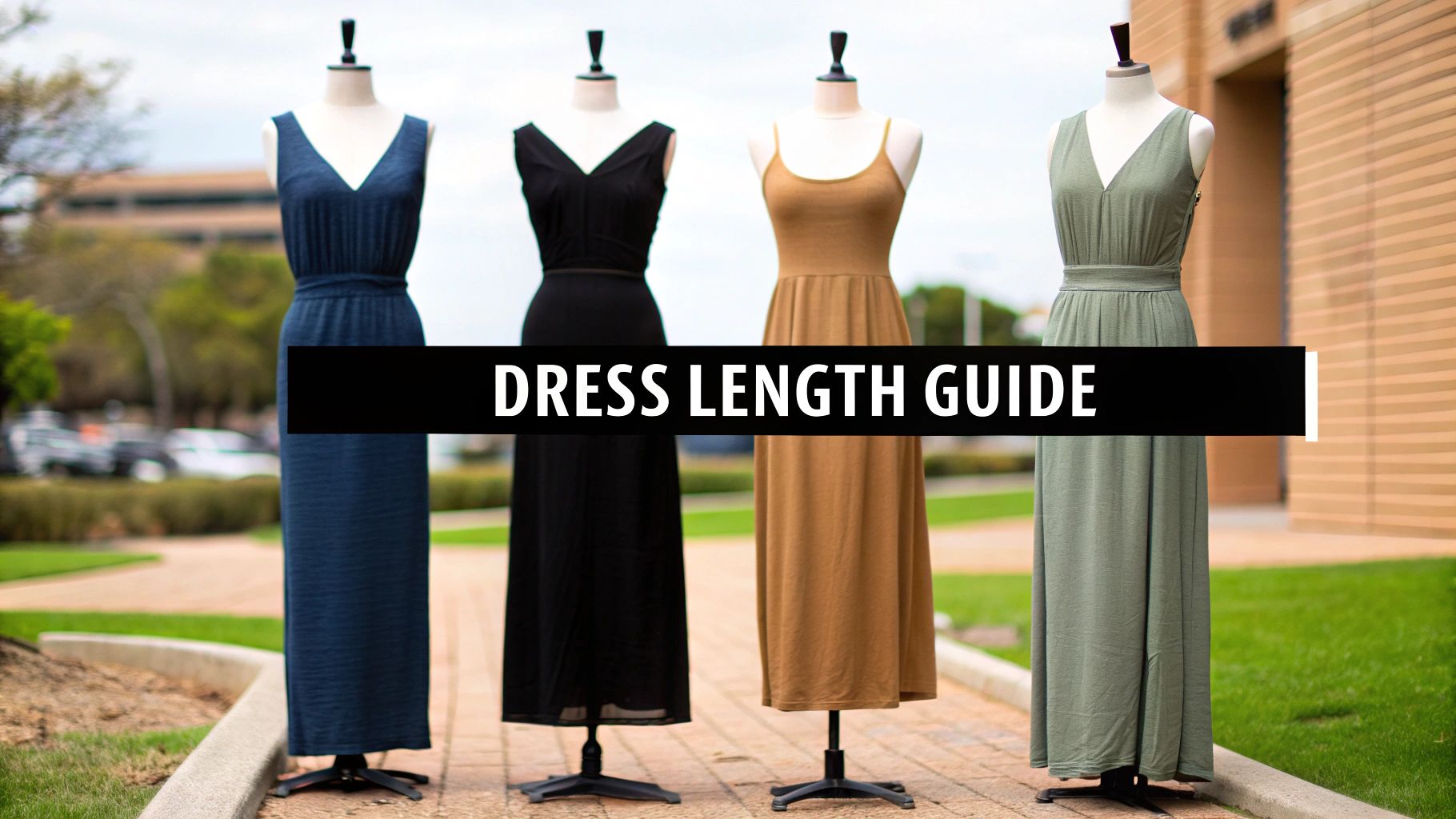Why Dress Length Changes Everything About Your Look
Think of a dress's hemline as the foundation of its entire story. It's the single detail with the most power to reshape your silhouette, boost your confidence, or signal that you're ready for a specific occasion. This isn't just about a few inches of fabric; it's about visual architecture. The right length can be your secret weapon, a tool that works with your body to create balance and guide the eye exactly where you want it to go. This core idea of the dress length guide is one many people overlook.
The effect of a hemline comes down to proportion and perception. A shorter hemline can make your legs look longer and add height to your frame, while a flowing maxi dress creates an unbroken vertical line, giving off an vibe of effortless elegance. Forget the outdated style "rules" that don't account for how fabric, cut, and your unique proportions all work together. The goal isn't to memorize a rigid chart but to understand why certain styles work so well.
The Power of Visual Perception
The way a dress length is perceived is more than just a measurement. It's about how the hemline interacts with the natural lines of your body—your knees, calves, and ankles. This interaction creates visual pauses or continuous lines, which completely changes how your overall frame is seen. It's a kind of everyday optical illusion that you have complete control over. For example, a hemline that cuts across the widest part of your calf can make your legs appear shorter, but one that falls just above or below that point creates a much more streamlined look.
The history of fashion is a perfect illustration of how much hemlines define the statement of an era.
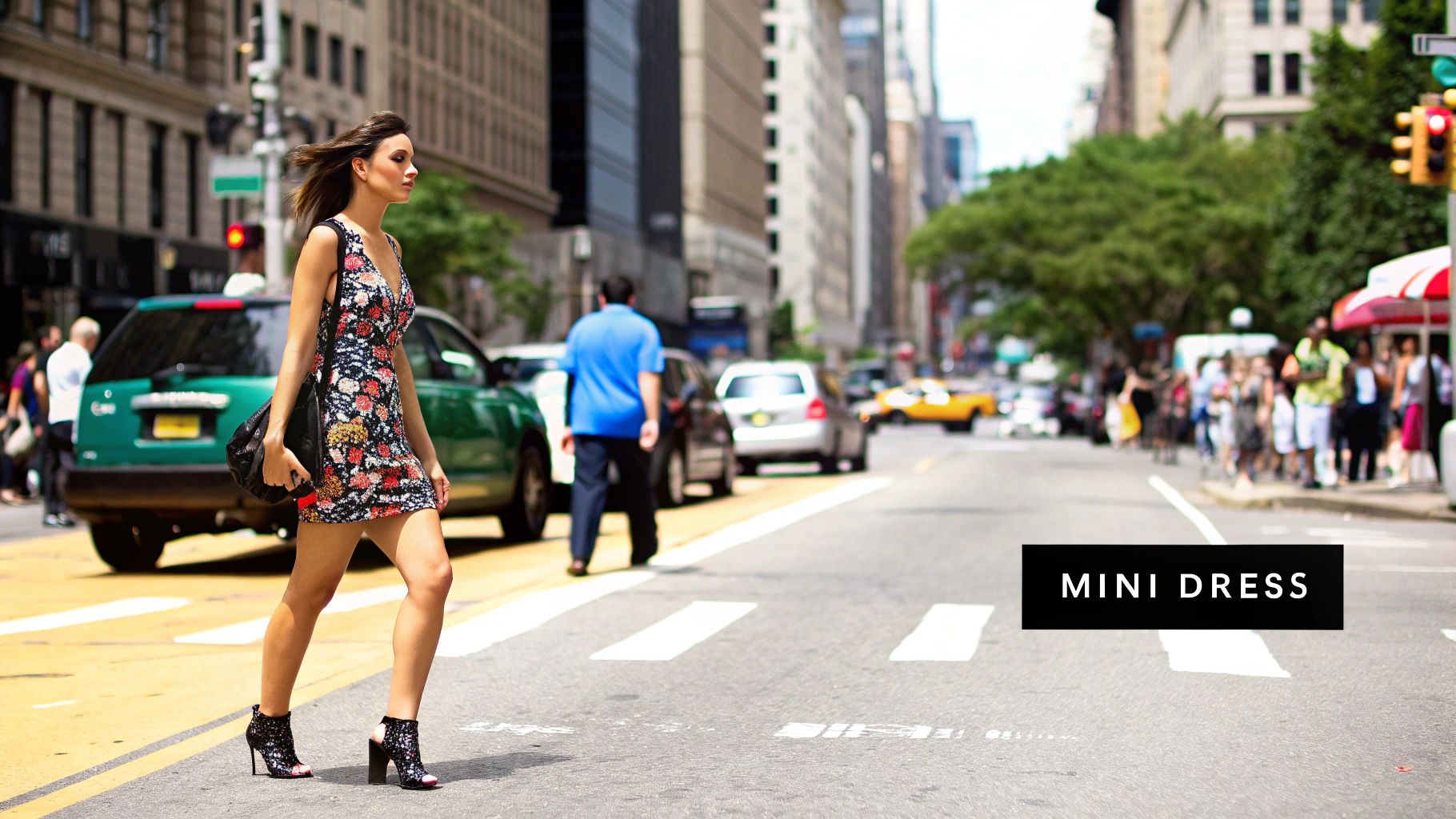
This visual timeline from Wikipedia shows that as societies and women's roles changed, so did popular dress lengths. This highlights their deep connection to both personal expression and the social environment. Grasping this power lets you make strategic choices, building a wardrobe where every single dress makes you feel poised and perfectly put-together, no matter the situation. Mastering this concept is the first step toward transforming your personal style.
Decoding The Four Essential Dress Lengths That Matter
To speak the language of style fluently, you first need to master the core vocabulary. In the world of fashion, the terms mini, knee-length, midi, and maxi are the fundamental building blocks of a great dress wardrobe. Think of them not as rigid rules, but as categories on a spectrum, each creating a distinct silhouette and mood.
These aren't just vague ideas; they are defined by a simple, practical measure: where the hemline falls in relation to your body. The most important anchor points are your knees and ankles. The infographic below simplifies this core concept, showing the primary hemline positions for the most common lengths.
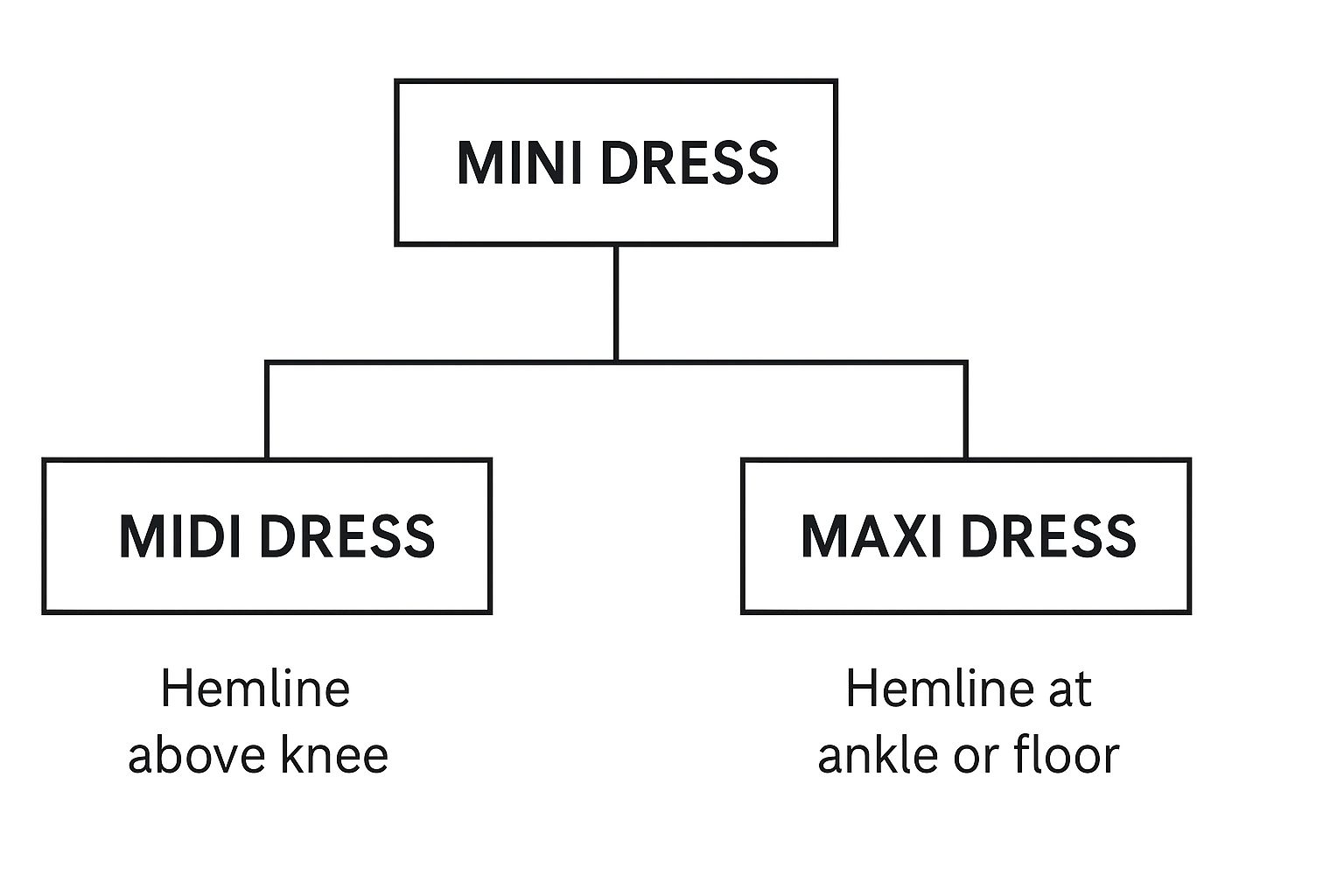
As the diagram illustrates, each length creates a very different visual line. The mini draws the eye upward, the midi creates a sophisticated midpoint, and the maxi establishes a long, unbroken silhouette.
The Mini and Knee-Length Dress
Mini dresses are defined by a hemline that sits comfortably above the knee, typically ending around the mid-thigh. It’s a bold, youthful choice that puts the focus squarely on your legs. A knee-length mini dress, its slightly more reserved cousin, offers much more versatility. Its hem can hit directly on, just above, or just below the kneecap.
This classic style strikes a perfect balance between professional polish and casual ease. It's a reliable staple for countless occasions, from the office to a weekend brunch.
The Midi Dress: The Modern Power Player
The midi dresses have seen a massive surge in popularity, and for good reason. Its hemline falls anywhere between the bottom of the knee and the lower calf. The power of this length is its adaptability; it can feel classic and demure or modern and edgy depending on the cut, fabric, and styling.
Because the midi's hemline can vary so much, finding the perfect one for your height and body proportions is key. A well-chosen midi can be incredibly flattering and is one of the most flexible pieces you can own. You can explore more about its range in our guide to versatile midi dresses for every occasion.
The Maxi Dress: Effortless Elegance
Finally, the maxi dresses feature a hemline that reaches the ankle or just skims the floor. It creates the longest possible vertical line, projecting an aura of grace and relaxed elegance. While often associated with summer days and beach vacations, the right maxi dress in a luxurious fabric can be stunningly formal.
The secret is in the material and fit. A well-draped maxi moves beautifully with you, creating a dramatic yet effortless statement that works for both casual and formal settings.
To help you visualize these differences and choose the right dress for any situation, we've created a handy reference chart. This table breaks down the specifics of each length, from hemline position to styling advice.
Complete Dress Length Reference Chart
Precise measurements and characteristics for each dress length category
|
Length Type |
Hemline Position |
Ideal Height Range |
Best Occasions |
Style Notes |
|---|---|---|---|---|
|
Mini |
Mid-thigh, well above the knee |
Best on petite to average heights |
Casual outings, parties, nights out |
Fun, youthful, and leg-centric. Pair with flats for a casual look or heels to elongate legs further. |
|
Knee-Length |
Falls just above, on, or just below the knee |
Universally flattering for all heights |
Work, semi-formal events, interviews |
A timeless and professional choice. The most versatile length for a wide range of functions. |
|
Midi |
Between the knee and lower calf |
Can work for all heights, but proportion is key |
Brunches, weddings, creative offices |
Modern and chic. Petite frames should look for hems just below the knee; taller frames can wear longer styles. |
|
Maxi |
Ankle-length or floor-sweeping |
Flattering on all heights, especially taller frames |
Beach vacations, summer events, formal galas |
Elegant and flowing. Creates a long vertical line. Can be dressed up or down with accessories. |
This chart acts as a quick guide to understanding the distinct personality of each dress length. As you can see, the difference of a few inches can completely change the vibe of an outfit, making it suitable for a boardroom or a beachside bar.
Finding Your Most Flattering Length for Your Body Type
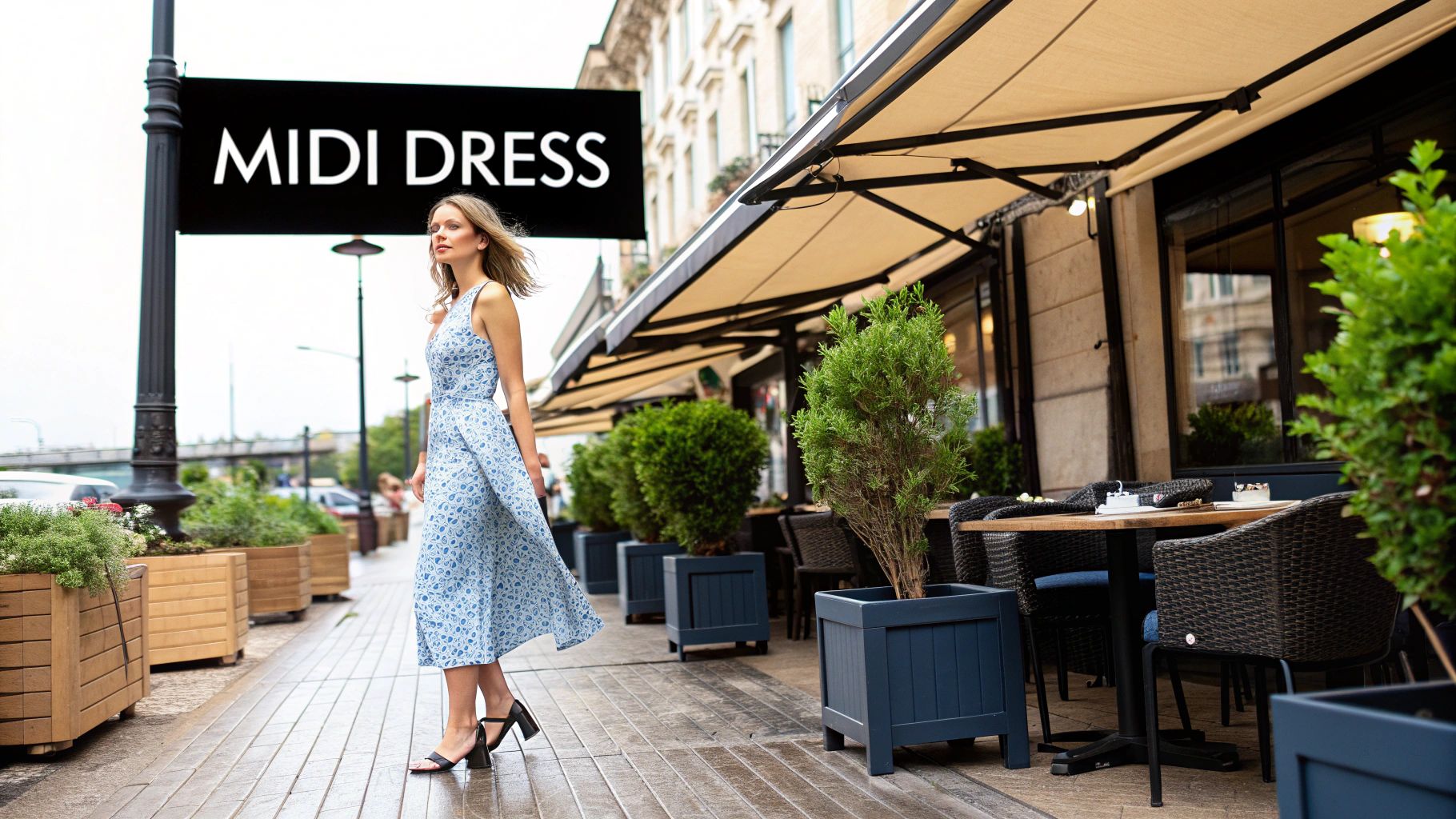
The key to a dress that truly sings on your frame has less to do with fleeting trends and more to do with your personal geometry. A length that looks stunning on your best friend might not have the same magic on you, simply because we all have beautifully unique proportions. It's time to move past outdated "body type" rules that try to sort everyone into a handful of boxes. Instead, let's focus on what actually matters: the ratio of your legs to your torso and where a hemline lands on your unique shape.
Think of a dress hemline as the frame for a piece of art. The right frame makes the art pop, and the right hemline does the same for your silhouette. Every hem creates a strong horizontal line, and the placement of that line can visually alter your proportions. It has the power to make your legs seem miles long, accentuate your waist, or create an elegant, continuous line.
Identifying Your Best Hemline Zones
To discover your personal sweet spots, stand in front of a full-length mirror wearing something that hugs your figure. Grab a towel or a piece of fabric and hold it horizontally across your legs, moving it up and down. Pay close attention to how each placement changes your overall look:
-
Above the knee: Does this create the illusion of longer legs? Many people find that a hemline hitting the narrowest part of the thigh is a fantastic choice.
-
At the knee: This is a timeless, reliable option for most, creating a balanced and polished silhouette.
-
Mid-calf: This length can be a bit tricky. If a hem cuts across the widest part of your calf, it can sometimes make the leg line appear shorter. Experiment by shifting the fabric just above or below that point to see the dramatic difference it makes. For more detailed advice on this popular length, check out our guide on how to choose the perfect midi dress for your body type.
Height and Proportion in Practice
Your height naturally plays a part in this sartorial equation. While these aren't strict commands, general observations can be a useful guide. Consumer research indicates that women 5'3" and under often gravitate toward knee-length or shorter styles to help elongate their figure. Those between 5'4" and 5'7" can effortlessly carry off mid-calf lengths. Taller women, standing 5'8" and above, often possess the versatility to rock nearly any length with confidence, from a bold mini to a flowing maxi.
You can dive deeper into the data that shapes the fashion market with these global apparel consumer insights. At the end of the day, the goal is to use this dress length guide to discover what makes you feel absolutely incredible.
Matching Dress Length To Every Occasion Like A Pro
Just as a specific key unlocks a specific door, the right hemline opens up the right social and professional opportunities. A dress is more than just fabric; it's a form of communication. The same length that looks fun and carefree for a weekend brunch can feel out of place in a corporate boardroom. Learning this unspoken language is a key part of any dress length guide, ensuring your style always sends the right message.
Think of your dress length like adjusting your tone of voice. A mini dress speaks in a playful, energetic tone that’s perfect for a party. A maxi dress, in contrast, often has a more relaxed, elegant mood suited for a garden wedding or beachside dinner. The challenge—and the fun—is in learning how to adapt your "voice" for any situation.
Navigating Professional Environments
In the workplace, confidence and clarity are everything, and your dress length should reflect that. Knee-length and midi dresses are the undisputed champions of corporate style. Their hemlines communicate professionalism without looking stuffy. A hem that falls directly on or just below the knee is a universally safe and powerful choice for interviews, client meetings, and daily office wear. This length projects competence and helps you stay focused.
The image below shows classic corporate attire, where hemlines are consistently at or below the knee, creating a polished and authoritative look.
Notice how the structured fabrics and conservative lengths work together to build a look of professional credibility. These styles prove that dressing for the office doesn't mean giving up your personality, but rather choosing lengths that support your career goals.
Decoding Social and Formal Dress Codes
Once you leave the office, the rules become more flexible, but the setting still dictates the style. To help you choose the perfect hemline for any event, we've put together a quick reference table. This guide breaks down what works, what to avoid, and how to style your look for everything from a casual brunch to a black-tie gala.
|
Occasion Type |
Recommended Lengths |
Lengths to Avoid |
Styling Tips |
Professional Notes |
|---|---|---|---|---|
|
Casual (Brunch, Shopping) |
Mini, Knee-length |
Floor-length, Formal Maxi |
Pair with sneakers or flat sandals for comfort. A denim jacket can complete the look. |
Focus on ease of movement and comfort. Breathable fabrics are a plus. |
|
Semi-Formal (Day Wedding, Dinner Party) |
Knee-length, Tea-length, Midi |
Mini, overly casual Maxi |
Opt for heels or elegant wedges. A statement necklace or clutch can elevate the outfit. |
Fabric choice is key. Silks, crepes, and polished cottons work well. |
|
Formal (Black-Tie, Gala) |
Maxi, Floor-length |
Mini, Knee-length |
Style with sophisticated heels, fine jewelry, and an elegant updo. |
A well-fitted gown is essential. Ensure the hem is tailored to your height with shoes. |
|
Business Formal (Conference, Board Meeting) |
Knee-length, Midi |
Mini, Maxi |
Choose closed-toe pumps and structured outerwear like a blazer. Keep accessories minimal. |
Conservative colors and high-quality fabrics project authority and seriousness. |
This table shows that the main difference between occasions is the level of formality and the expectations of the environment. While a casual event is all about comfort and personal expression, a formal event requires a more traditional and elegant approach.
Here's a simple breakdown for your social calendar:
-
Casual Events (Brunch, Shopping): Mini and knee-length dresses are perfect. They are comfortable, easy to move in, and match the relaxed atmosphere.
-
Semi-Formal (Weddings, Dinner Parties): Midi and tea-length dresses truly shine here. A vibrant floral midi, for instance, is ideal for a daytime wedding. If you're looking for more ideas, you might like our guide on dressing for special occasions.
-
Formal Occasions (Galas, Black-Tie Events): Maxi or floor-length gowns are the standard. The long, unbroken line of a maxi dress creates the elegance and drama needed for the most formal settings.
Ultimately, choosing the right length is about respecting the occasion while honoring your personal style. It's the skill that takes your fashion sense from simply wearing clothes to making a statement.
Styling Tricks That Transform Any Dress Length
The real magic in any dress length guide starts when we move beyond fit and into the art of styling. Think of a dress as a blank canvas; the right accessories and layers are your paintbrushes, capable of changing its entire personality. Strategic styling helps you unlock the full potential of every piece in your wardrobe, letting you create several unique looks from a single item.
Styling is the final, essential touch that defines how a dress comes across. The same midi dress can feel polished and work-ready with a pointed heel, or it can become edgy and cool with a chunky combat boot. The secret is understanding how different elements play with the hemline to create a balanced and intentional look.
The Power of Footwear and Belts
Your choice of shoes does much more than just add height—it recalibrates your entire outfit’s proportions.
-
With Mini Dresses: Flats or sneakers give off a casual, playful feel. Heels, especially delicate, slender ones, make your legs look miles long.
-
With Midi Dresses: Heels are often a midi’s best friend. They prevent the mid-calf hemline from visually shortening your legs. A shoe with a pointed toe is particularly effective at creating an elongated line.
-
With Maxi Dresses: Wedges or platform sandals offer height without the formality of a stiletto, making them perfect for a flowy, bohemian style.
Belts are another game-changing accessory. Cinching a belt over a loose-fitting dress can instantly define your waist and create an hourglass shape. It can also visually break up the long fabric of a maxi dress or even hike up the hem of a midi for a quick, no-sew adjustment.
Strategic Layering and Trend-Conscious Choices
Layering with jackets or cardigans introduces new lines and dimensions to your look. A cropped jacket paired with a midi dress draws attention to the waist, while a long duster coat over a mini dress adds a touch of drama and sophisticated coverage.
This is especially true in fashion today, where social media plays a huge role in setting trends. For example, the "quiet luxury" aesthetic, often seen on platforms like Instagram, shows just how impactful styling can be.
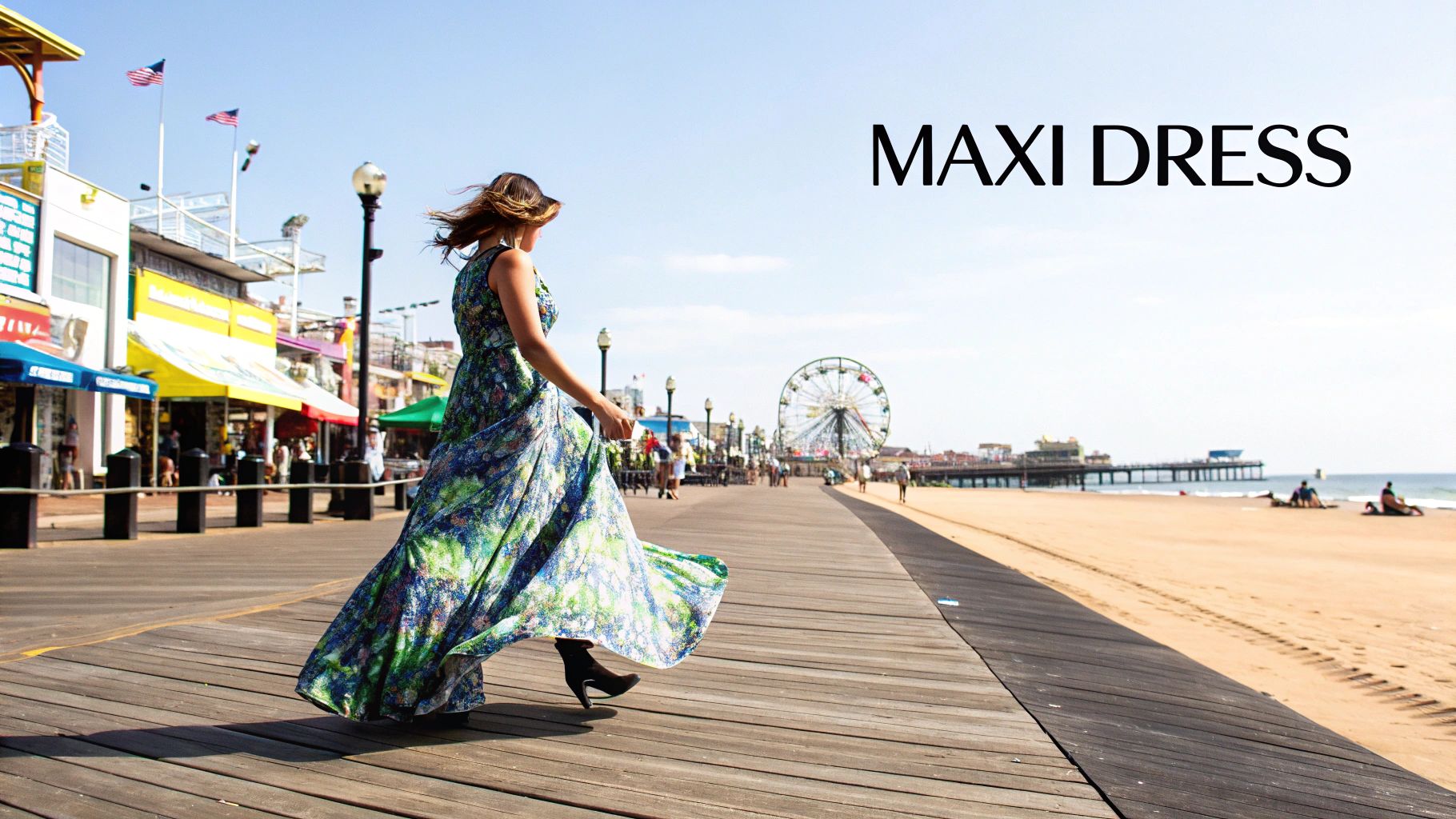
The image above demonstrates how refined, longer hemlines are styled with simple, high-quality accessories to achieve an elegant and understated look. Trends like these gain traction on platforms where 78% of consumers find clothing inspiration. Another popular movement, the "Minimalist Renaissance," is favored by 55% of consumers aged 18-24 and champions these graceful, longer hemlines over more ostentatious styles. You can learn more about the cultural impact of fashion trends to see how online movements are shaping the clothes we wear.
Getting the Perfect Fit Through Smart Alterations
It’s a familiar story: you find a dress that’s almost the one, but the length is just a little off. This isn't a deal-breaker; it's an opportunity. Adjusting the hemline is often one of the simplest and most effective alterations you can make. It’s the final touch that takes a good dress and makes it a garment that seems custom-made just for you.
This isn't just about snipping away extra fabric. A strategic alteration refines the entire silhouette, ensuring it flatters your body perfectly. With the global market for dresses and skirts hitting around $106.59 billion in 2025, it's clear these pieces are central to our wardrobes. Spending a little extra on alterations to make your favorites fit flawlessly is a smart investment, especially in a market projected to grow by 2.63% annually through 2029. You can learn more about the consumer forces behind these figures in these worldwide apparel market trends.
When to Alter vs. When to Pass
Learning to spot a dress with good alteration potential is a valuable shopping skill. Simple length adjustments on dresses with plain hems—those without intricate lace, beading, or scalloped edges—are usually quick and affordable. These are the green flags telling you an alteration is a worthwhile investment.
On the other hand, it's often best to walk away if the hem features complex details that would be costly or even impossible to recreate accurately. Also, be wary of dresses that are too short. Adding length seamlessly is incredibly challenging and rarely looks right. The best candidates for alteration are almost always those that need to be shortened, not lengthened.
Communicating with Your Tailor
To get the results you envision, clear communication with your tailor is key. Simply saying "make it shorter" leaves too much to chance. For a successful fitting, try these tips:
-
Bring the Right Shoes: Always, always wear the exact shoes you plan to pair with the dress. The height of a heel can dramatically change where a hemline falls, so this is a non-negotiable step.
-
Be Specific: Use clear, descriptive language. Instead of being vague, say, "I'd like the hem to hit right at the top of my kneecap," or "Could we bring it up by one inch?" This removes any guesswork.
-
Trust Their Expertise: A skilled tailor has a deep understanding of how different fabrics drape and fall. Be open to their suggestions—they might propose a technique or a slightly different length you hadn't considered that will achieve an even better result.
Building Your Strategic Dress Length Wardrobe
Now it's time to put all this style knowledge into action. We’re moving from the world of fashion theory to the practical task of building a wardrobe where every dress has a purpose. The goal is to make getting dressed a genuinely enjoyable process, filled with pieces that fit your real life. This isn't about just buying more clothes; it’s about becoming a strategic editor of your own closet.
A truly functional wardrobe is built around your personal lifestyle, not some generic style guide. It has to work for you. Are you heading to a corporate office five days a week? Do you work from home but have a packed social calendar? Maybe you're a busy parent who needs comfort and easy-to-wear pieces above all else. The most versatile dress lengths for a lawyer will look very different from those for a freelance artist.
Identifying Gaps and Opportunities
The first step is a simple wardrobe audit. Think of it as taking inventory of your current dress collection. Lay out your dresses and start sorting them by length. You might find you have a dozen casual knee-length dresses but nothing for that upcoming formal wedding. Or perhaps your closet is full of fun mini dresses, but you lack a single polished midi for professional settings. This isn’t about judgment—it's about gathering data to make smarter choices.
Using a wardrobe planning tool can make this process incredibly visual.
This screenshot from a wardrobe planning system shows how categorizing items reveals what you own and what you're missing. Seeing your collection laid out like this makes it immediately obvious where the gaps are, helping you create a targeted shopping list instead of just guessing.
Developing Your Shopping Strategy
Once you know what’s missing, you can shop with a clear purpose. This approach is about buying smarter, not just buying more. Your goal is to find pieces that fill those specific gaps and complement the dresses you already love. This creates a system where items can be mixed and matched effortlessly. A well-rounded collection might include:
-
Two Go-To Work Dresses: A classic knee-length silhouette and a polished midi are excellent foundations for a professional wardrobe.
-
One Versatile Weekend Dress: Look for a comfortable knee-length or mini dress in a durable, easy-care fabric.
-
One "Wow" Event Dress: A stunning midi or maxi in a luxe fabric will have you covered for weddings, special dinners, and formal parties.
This mindset transforms shopping from a reactive habit into a strategic activity. Every purchase becomes an investment in a more cohesive and functional closet. By carefully choosing dresses based on length and occasion, you build a collection where every single piece makes you feel confident and perfectly put-together.
Ready to build your own strategic wardrobe? Explore the curated midi, maxi, and mini dresses at BTK COLLECTIONS and find the perfect foundational pieces to complete your collection.


